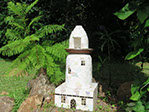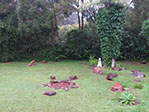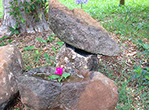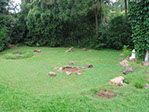Miyagawa Landscapes
Japanese Gardening | Byron Bay
ABN 62692022470
Rock Garden
Byron Bay, Australia
Adhering to classic stylization of Japanese traditional landscaping principles, this garden is a miniature representation of the Cape Byron coastline. After relocating from Japan, Kan commenced an in-depth study of local materials (soil, rocks, plants) and closely observed the seasonal changes. He spent many hours studying the natural landscape formations and appreciating the inherent beauty of form and living entities on the land and in the sea. He observes the 100-strong dolphin pod, and avidly watches the mid-year migration of humpback whales past Julian Rocks and the lighthouse upon the Cape.
These local landscape elements provide the inspiration for this masterpiece, replete with a fire-pit shaped like a large turtle swimming out towards the famous landmark “Julian Rocks”. Other carefully selected and placed rocks represent a breaching whale and playful dolphins. Kan created a Gaudi-inspired mosaic lighthouse for “the most easterly point”, and planted a jacaranda tree beside it. The tree is angled to grow in a way that its purple petals will drop to become the ocean surface where the symbolic cetaceans swim.
Rather than represent the ocean expanse with raked gravel, as is often done in the classic style, Kan has retained the lawn, and regularly mows it in such a way that the shape of the coast and shoreline are clearly discernable. In the distance, beyond “Tallow Beach”, is a rock with a concave surface symbolizing a passing ship.
In another area of this property, there is a modern take on the roji teahouse garden, created for tea service. In the shade of a tall tree, four large rocks are set in place: a central table, surrounded by three chairs. It also includes stone structures shaped like crescent moons, and live flowering ikebana, as offerings to the spirits of nature. From this “teahouse” the Cape Byron View Garden can be contemplated at leisure.
>
<
USE THE CONTACT FORM OR PHONE 0427 423 723 TO BOOK
AN ON-SITE CONSULTATION
FOR YOUR GARDEN PROJECT













